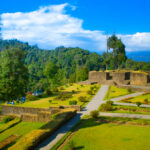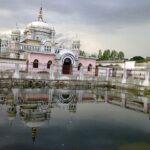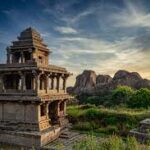Now Reading: Top 5 Best Places Visiting in Panchkula for Nature, Spirituality & Heritage
-
01
Top 5 Best Places Visiting in Panchkula for Nature, Spirituality & Heritage

Top 5 Best Places Visiting in Panchkula for Nature, Spirituality & Heritage
1.Mata Mansa Devi Temple

Northern India hosts one of its most worshiped Hindu religious centers at the Mata Mansa Devi Temple located within Panchkula district in Haryana. Goddess Mansa Devi as a Shakti manifestation powers the temple which generates substantial religious value by drawing thousands of devotees seeking spiritual help and prayer fulfillment.
Hindu mythology says that Goddess Mansa Devi accepts requests from her followers and grants their prayers. Ancient lore evokes Shakti in her by describing her as an embodiment of female protective power along with energy and strength. The Goddess is believed to answer prayers at this temple which takes its name “Mansa” or “wish” because of this power.
The temple possesses a mystical quality because an ancient rock bears the handprint of Goddess Mansa that enhances its sacred status.
This temple possesses an interesting feature that includes a sacred tree under which visitors tie different colored threads for prayer requests to achieve their desired outcomes. Believers think the temple responds to their prayers and numerous people come back after their wishes materialize to remove their sacred threads.
2.Morni Hills

Morni Hills exists as a peaceful destination within Panchkula district of Haryana where it rests among the Shivalik mountain range. The environment here consists of abundant forest vegetation and diverse wildlife together with an atmosphere that makes people attracted to experience the countryside while escaping urban commotion.
Morni Hill station took its name from a queen who historically ruled this part of the territory during ancient times. The two natural lakes in Morni Hills attract legends because they seem separate but have a strange connection between them. The region gains additional appeal because of its mysterious natural linkage between two lakes.
Morni Hills reaches a height of 1,267 meters which grants breathtaking views across different hills alongside valleys and thick forests. Naturalists will find Morni Hills attractive because it houses various plant communities that attract a wide array of animal species. During their visits visitors commonly encounter multiple types of birds that include peacocks together with quails and partridges alongside jackals and langurs and wild boars.
Best Time to Visit
Morni Hills presents its ideal conditions for exploration from March to May during spring and September to November during the autumn season. The natural environment receives major improvements during Monsoon months and enjoyable winter months present a refreshing climate.
3.Sukhna Wildlife Sanctuary

The Sukhna Wildlife Sanctuary exists as an ecologically vital and peaceful zone that occupies 2,600 hectares within the Shivalik foothills of the outer Himalayas. The official declaration of this wildlife sanctuary in 1998 took place near Sukhna Lake within the Union Territory of Chandigarh that overlaps into Panchkula district of Haryana. The sanctuary attracts wildlife enthusiasts together with nature lovers who seek peace while birdwatching in this lush sanctuary teeming with biodiversity.
Small hills and seasonal rivulets together with thick forests create a photogenic trek along with an attractive environment for both photographers and hikers. The region maintains the proper water management of Sukhna Lake by functioning as its water collection area which supports both water supply and ecological equilibrium. The sanctuary gains additional beauty through seasonal streams that provide habitat areas for amphibians and many aquatic species.
Activities and Attractions
- Nature Trails and Trekking
Visitors have multiple nature trails available which lead through the sanctuary giving them amazing vistas of hill scenery along with valley views. The sanctuary provides walking paths that suit everyone from wilderness trekkers to pocket hikers who desire natural solitude. - Bird Watching
Attractions for bird watching are attracted to the sanctuary because of its dense bird population. You can easily see colorful resident and migratory birds at the sanctuary during both early morning and late afternoon periods. - Photography and Wildlife Observation
Nature observation and wildlife photography thrive in Sukhna Wildlife Sanctuary because it contains various animal species and attractive natural scenery. - Educational and Recreational Visits
Students together with researchers interested in biodiversity can visit the sanctuary for educational purposes.
Best Time to Visit
The prime period to explore Sukhna Wildlife Sanctuary runs from October through March because the climate is nice along with the possibility of viewing migrating birds. After the monsoon season the vegetation becomes denser creating additional beauty for the sanctuary.
4.Cactus Garden Panchkula

The Cactus Garden operates officially as the National Cactus and Succulent Botanical Garden and Research Centre while being found in Sector 5 Panchkula Haryana India. The garden opened its doors in 1987 under Dr. J.S. Sarkaria’s leadership to become Asia Pacific’s largest botanical facility for unusual species of Indian succulents.
Tourists may discover natural beauty in the garden that provides educational content detailing plant ecology together with survival adaptations. Guests who stroll through the garden will find pleasure in examining the delicate features of cactus species while being amazed by the various dry-environment plant varieties.
Well-kept pathways together with carefully planned plant arrangements at the garden provide visitors with a peaceful experience which attracts all groups including families students and researchers.
Best Time to Visit
The Cactus Garden invites visitors annually yet spring and winter seasons (October to March) are optimal periods because of agreeable weather along with the peak blooming season for different succulents. Visitors can experience the most active period of the Cactus and Succulent Show in March as an ideal time to walk through the garden.
5.Tikkar Taal

Natural tourist destination Tikkar Taal stands in the Morni Hills near Panchkula within the Haryana state of India. The scenic location draws more and more visitors because it offers peaceful lakes and greenery together with outdoor thrills that suit families and nature enthusiasts and adventure seekers who want to escape urban distractions.
Visitors can enjoy a complete experience at Tikkar Taal because it provides peaceful surroundings along with exciting adventures combined with historical spots. The lakeside position suits relaxing moments but many adventure enthusiasts love the trekking trails and outdoor adventures. The region provides several small restaurants alongside its picnic areas for visitors who want to eat local dishes with natural surroundings.
Best Time to Visit
Visitors should plan their visit to Tikkar Taal within the spring and winter months between October and March because these seasons deliver pleasant weather for outdoor activities. Tikkar Taal experiences both hot summer days and refreshing air that comes from the lakes. The rainy season of the region introduces plenty of greenery yet trekking becomes risky because of dangerous trail conditions.
Related articles : Top 5 Best Places Visiting in Palwal for Heritage, Spirituality & Nature
Stay Informed With the Latest & Most Important News
Previous Post
Next Post
-
 01Top 5 Best Places Visiting in Gyalshing – Monasteries, Lakes & Scenic Escapes
01Top 5 Best Places Visiting in Gyalshing – Monasteries, Lakes & Scenic Escapes -
 02Top 5 Best Places Visiting in Panna – Temples, Waterfalls & Wildlife Escapes
02Top 5 Best Places Visiting in Panna – Temples, Waterfalls & Wildlife Escapes -
 03Top 5 Best Places to Visit in Malerkotla – Malerkotla Fort, Sheesh Mahal & More
03Top 5 Best Places to Visit in Malerkotla – Malerkotla Fort, Sheesh Mahal & More -
 04Top 10 Best Places Visiting in Dakshina Kannad for Culture, Nature & Coastal Charm
04Top 10 Best Places Visiting in Dakshina Kannad for Culture, Nature & Coastal Charm -
 05Top 2 Best Places Visiting in Chitradurga for History, Nature & Adventure
05Top 2 Best Places Visiting in Chitradurga for History, Nature & Adventure -
 06Best Places Visiting in Shopian – Explore Top Attractions & Hidden Gems
06Best Places Visiting in Shopian – Explore Top Attractions & Hidden Gems -
 07Best Places Visiting in Narmadapuram – Temples, Waterfalls & Wildlife Escapes
07Best Places Visiting in Narmadapuram – Temples, Waterfalls & Wildlife Escapes














Pingback: Top 5 Best Places Visiting in Panipat – Explore Haryana's Historic City